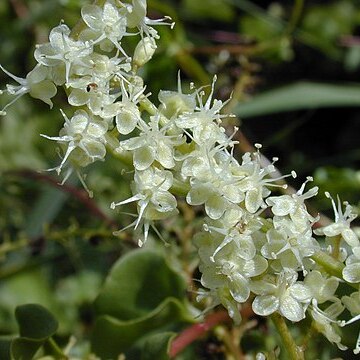Vines or scramblers. Stems and roots sometimes producing tubers. Leaves alternate, petiolate, simple, entire, slightly fleshy. Inflorescence an axillary or terminal spike or raceme, sometimes branched. Flowers pedicellate, chasmogamous, fragrant. Bracteoles 2 or sometimes interpreted as 4 (including 2 sepals) with pedicels having 2 pairs of decussate bracteoles appressed to perianth (the lower pair connate and persistent or free and caducous, the upper pair sepaloid). Sepals 2, sometimes (not in Australia) keeled or winged. Tepals 5, shortly connate at base and spreading above. Stamens 5, straight, splayed outward and strongly emergent; anther filaments tapered, connate at their broad bases into a ring partially concealing ovary; anthers dorsifixed, versatile, longitudinally dehiscent. Style 1, undivided (not in Australia) or 3-partite almost to base; stigmas simple or forked, papillose. Fruit nut-like, surrounded or (not in Australia) completely enclosed by persistent dry perianth parts. Seeds lentiform with a semi-circular or horseshoe-shaped embryo.
Branched vines with annual shoots from a fleshy rhizome. Leaves slightly fleshy, sessile or petioled. Racemes or spikes axillary, simple or branched. Bracts persistent or caducous; pedicels (if any) persistent, articulate below the perianth. Apex of the pedicels with two pairs of decussate bracteoles appressed to the perianth; lower pair small, connate and persistent forming a cuplet, or free and caducous; upper pair tepaloid, convex or boat-shaped, often keeled on the back, sometimes narrowly winged, rarely broadly winged. Flowers bisexual (or unisexual). Tepals connate at the base, forming a hollow concealing the ovary, segments patent in anthesis, thin, later ± thickened and enclosing the fruit. Filaments filiform broadened towards the base. Style 1 with 3-lobed stigma or split to various degree into arms, eventually into 3 free styles each with a globular to oblong or club-shaped, papillose stigma; arms sometimes forked, each with a linear stigma. Fruit globose, enclosed by the perianth; pericarp fleshy or perga-mentaceous. Seed lens-shaped.
Vines climbing on shrubs, glabrate, mostly slender; rhizomes sometimes with fleshy tubers. Leaves ovate or elliptical, sometimes succulent, sometimes drying dark, pinnately few veined; petiolate; exstipulate. Inflorescences axillary, some-times more or less terminal sparingly branched, lax racemes, the pedicels short, slender, subtended by linear bracts, the flowers subtended by 2 or 4 decussate sometimes basally connate bracteoles. Flowers perhaps sometimes unisexual, perianth 5-parted, basally connate; stamens 5, inserted at the base of the calyx lobes, the anthers oblong, versatile, basifixed; ovary globose or ovoid, 1-locular, sometimes partially partitioned, with 1 basal, campylotropous ovule, the styles basally united, short, the stigmas 3, linear or clavate, sometimes only small porrect lobes on the style, sometimes bifid. Fruit globose, enclosed by the perianth, sometimes samaroid within the accrescent bracteoles; seed reportedly globose or reniform.
Vines herbaceous, branched. Leaves sessile or petiolate, slightly fleshy. Racemes axillary, rarely branched. Flowers pedicellate; pedicel persistent, articulated below the perianth, apex with 2 pairs of decussate bracteoles adnate to the perianth; lower bracteoles small, connate and persistent or free and caducous; upper bracteoles tepaloid, convex or boat-shaped, often keeled abaxially, sometimes narrowly winged, rarely broadly winged. Perianth segments membranous, spreading rotate at anthesis. Petals connate at base, segments thin, patent in anthesis. Filaments filiform, broadened toward base, reflexed in bud. Styles 3; stigmas globular or club-shaped, papillose. Fruit ovoid to globose, enclosed by perianth, pericarp fleshy or parchmentlike. Seed lens-shaped.
Glabrous vines with annual shoots arising from a fleshy rhizome. Lvs ± succulent, sessile or petiolate. Fls ☿ or unisexual, in simple or branched racemes or spikes. Bracts persistent or caducous. Bracteoles 4, in 2 decussate pairs appressed to perianth; lower pair small and free or connate; upper pair tepaloid and keeled. Tepals connate at base, enclosing ovary; segments patent at anthesis. Style usually 1 and splitting to varying degrees, sometimes 3; stigmas 1-2 to each arm, linear to globose. Fr. globose, enclosed by perianth; pericarp fleshy or parchment-like. Seeds lens-shaped.
Twining vines; rhizomes sometimes with fleshy tubers. Leaves petiolate; blade ovate or elliptical, glabrous, sometimes succulent. Inflorescences axillary (sometimes terminal), pendent, of sparingly (1-to 3)branched racemes, lax; pedicels short, slender; bract linear; flower subtended by 2 bracteoles. Tepals basally connate, white; stamens 5, inserted at base of tepals, filaments white, hyaline, flattened, curved in bud, anthers oblong, versatile or basifixed; styles and stigmas 3. Fruit a globose utricle enclosed by perianth and accrescent bracteoles.
Lower bracteoles connate at the base forming a persistent cuplet on top of the pedicel.
Lower bracteoles free, caducous.

